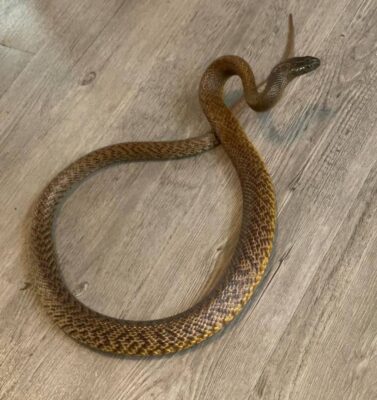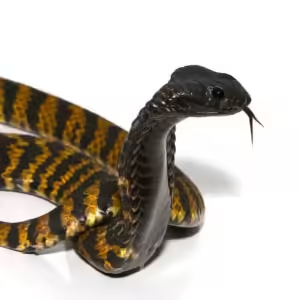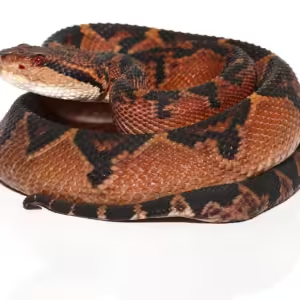Inland Taipan for Sale
$1,499.99
Inland Taipan
The inland taipan, scientifically known as Oxyuranus microlepidotus, holds the title of the world’s most venomous snake. This species is also commonly referred to as the ‘fierce snake’ or ‘small-scaled snake’, both of which emphasize its potent venom and unique physical characteristics. The inland taipan is primarily distributed in the arid regions of Australia, particularly within Queensland, where it thrives in a variety of habitats that include grasslands, open woodlands, and sparse scrub. These habitats are well-suited for the snake, allowing it to effectively regulate its body temperature and evade predators.

Inland Taipan
The inland taipan, scientifically known as Oxyuranus microlepidotus, holds the title of the world’s most venomous snake. This species is also commonly referred to as the ‘fierce snake’ or ‘small-scaled snake’, both of which emphasize its potent venom and unique physical characteristics. The inland taipan is primarily distributed in the arid regions of Australia, particularly within Queensland, where it thrives in a variety of habitats that include grasslands, open woodlands, and sparse scrub. These habitats are well-suited for the snake, allowing it to effectively regulate its body temperature and evade predators.
Adaptation to the Australian environment plays a crucial role in the survival of the inland taipan. This snake is particularly interesting due to its preference for habitats that offer a substantial amount of prey, primarily rodents, which are abundant in the regions it inhabits. Its dietary habits not only contribute to the local ecosystem by controlling rodent populations but also highlight the intricate relationships that exist between species in arid environments. The adaptability of the inland taipan to its surroundings is reflected in its hunting strategy and nesting behaviors, which optimize its chances of survival.
The understanding of the inland taipan within the context of its ecosystem is essential for appreciating its ecological significance. As a top predator, it plays an integral role in maintaining the balance of the habitats it occupies. Furthermore, studying this snake aids in informing conservation efforts, as its presence is indicative of environmental health. In recognizing the importance of the inland taipan, we can gain valuable insights into the dynamics of Australian ecosystems and the roles that various species, including this fascinating snake, play within them.
Physical Characteristics and Behavior
The inland taipan, scientifically known as Oxyuranus microlepidotus, is renowned for being the world’s most venomous snake. This formidable reptile can reach an impressive length of up to 3 meters (approximately 10 feet), making it one of the largest snakes found in Australia. Its slender, elongated body is complemented by a unique coloration that varies with the season. Typically, the inland taipan exhibits a pale tan or light brown hue with darker bands or stripes, effectively camouflaging it within its arid desert habitat.
One of the most distinctive features of the inland taipan is its large, flattened head, which is significantly wider than its neck. This adaptation enhances its feeding capabilities, allowing it to consume larger prey. Moreover, it possesses a potent venom that can immobilize small mammals almost instantaneously. This neurotoxic venom contains a complex mixture of enzymes and proteins, specifically adapted for rapid prey capture and digestion. Understanding the morphology of the inland taipan provides valuable insights into its predatory prowess.
Behaviorally, the inland taipan is primarily diurnal, exhibiting a high level of activity during the day, particularly in the cooler hours. Its hunting patterns are methodical and precise; the snake usually stalks its prey, which predominantly includes rabbits and rodents. When hunting, the inland taipan displays remarkable patience, often remaining motionless for extended periods before striking. Additionally, this snake is characterized by its solitary nature, preferring to inhabit its territory without the presence of others. The combination of its physical attributes and behaviors plays a crucial role in its survival within the harsh Australian landscape, allowing it to thrive despite its formidable predatory competition.
Venom: Composition and Effects
The venom of the Inland Taipan (Oxyuranus microlepidotus) is renowned for being the most toxic of any snake species, a fact that is supported by its complicated chemical composition. This venom is primarily comprised of a cocktail of neurotoxins, hemotoxins, and myotoxins, each playing a distinct role in subduing prey. Neurotoxins present in the venom target the nervous system, leading to paralysis, while hemotoxins cause damage to blood cells and tissues. Myotoxins work to destroy muscle tissue, complicating the physiological effects for any animal that falls victim to this snake’s bite.
During an encounter with its prey, the Inland Taipan effectively delivers venom through its specialized fangs. These fangs are long, hollow, and capable of injecting a significant volume of venom into the victim’s bloodstream in a fraction of a second. The initial effect is rapid, resulting in swift incapacitation of smaller mammals, such as rodents, which are the Taipan’s preferred prey. This rapid action is essential for the snake, as it ensures the prey is subdued before it can escape.
The physiological effects of the venom are profound and often lethal. Upon injection, symptoms may include severe swelling, internal bleeding, and cardiovascular collapse. In humans, a bite can lead to death within hours if antivenom is not administered promptly. Case studies have documented instances of individuals suffering from bite incidents, illustrating how quickly the venom acts and the critical need for medical intervention. Despite its deadly capabilities, the Inland Taipan is typically reclusive and avoids human contact, making bites exceedingly rare. Understanding the composition and effects of its venom not only highlights its danger but also emphasizes the importance of respect for this unique species in its natural habitat.
Conservation Status and Human Interaction
The inland taipan (Oxyuranus microlepidotus), known for its immense venom potency, currently holds a status of “Least Concern” on the IUCN Red List. However, this designation does not diminish the necessity for vigilance regarding its conservation. The primary threats to the inland taipan’s population arise from habitat destruction due to agricultural expansion, urban development, and climate change. As its natural habitat diminishes, the survival of this species becomes increasingly precarious.
Human interaction plays a significant role in shaping the fate of the inland taipan. Many misconceptions surrounding this snake contribute to negative perceptions and unnecessary fear. Myths suggesting that the inland taipan aggressively seeks out humans are unfounded, as they are generally reclusive and prefer to avoid contact. Education is essential in dispelling these myths and fostering a better understanding of their behavioral patterns. By promoting public awareness, we can encourage the peaceful coexistence of humans and this remarkable species.
Conservation strategies must consider habitat preservation and restoration, allowing the inland taipan to thrive in its natural environment. Implementing protective measures such as wildlife corridors can facilitate movement between habitats, mitigating the impacts of habitat fragmentation. Additionally, ongoing research into the taipan’s ecology is vital to informing conservation efforts. By understanding their behaviors and interactions within ecosystems, we can develop targeted strategies to enhance their survival rate.
Public engagement initiatives, such as educational programs and wildlife conservation campaigns, can serve as effective tools for fostering a more supportive attitude toward the inland taipan. Collaboration between government agencies, conservation groups, and local communities is paramount to securing the future of this snake. Ultimately, it is imperative to prioritize conservation efforts, as the inland taipan remains an integral part of Australia’s unique biodiversity.
Fascinating Facts About the Inland Taipan
The Inland Taipan, also known scientifically as Oxyuranus microlepidotus, is renowned for being the world’s most venomous snake. Its lethal venom can achieve a potency that is over fifty times stronger than that of the famous black mamba, making it a subject of both admiration and caution within herpetological studies. Despite its dangerous reputation, the Inland Taipan is reclusive and prefers a solitary existence in arid regions of Australia, particularly within the vast plains of Queensland. This elusive nature makes sightings extremely rare, contributing to the mystique surrounding this remarkable species.
In addition to its frightening potency, the Inland Taipan boasts a fascinating adaptation of coloration. Its scales display a unique hue that shifts from olive green to brown, helping it blend seamlessly into the sun-drenched landscapes of its habitat. This natural camouflage is vital for both hunting and evasion from potential threats. Further underscoring its extraordinary traits, the Inland Taipan primarily feeds on small mammals, such as rodents, employing a swift and precise striking technique to deliver its venom quickly.

Be the first to review “Inland Taipan for Sale” Cancel reply
Related products
Venomous



















Reviews
There are no reviews yet.